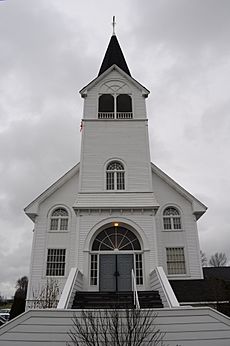Skagit County, Washington facts for kids
Quick facts for kids
Skagit County
|
||
|---|---|---|
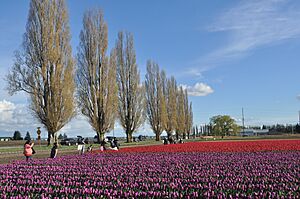
Tulip fields in the Skagit Valley
|
||
|
||
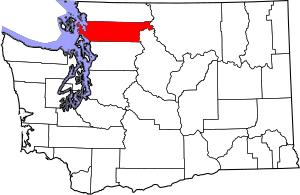
Location within the U.S. state of Washington
|
||
 Washington's location within the U.S. |
||
| Country | ||
| State | ||
| Founded | November 28, 1883 | |
| Named for | Skagit tribes | |
| Seat | Mount Vernon | |
| Largest city | Mount Vernon | |
| Area | ||
| • Total | 1,920 sq mi (5,000 km2) | |
| • Land | 1,731 sq mi (4,480 km2) | |
| • Water | 189 sq mi (490 km2) 9.8%% | |
| Population
(2020)
|
||
| • Total | 129,523 | |
| • Estimate
(2023)
|
131,417 |
|
| • Density | 71/sq mi (27/km2) | |
| Time zone | UTC−8 (Pacific) | |
| • Summer (DST) | UTC−7 (PDT) | |
| Congressional district | 2nd | |
Skagit County /ˈskædʒɪt/ is a county in the U.S. state of Washington. As of the 2020 census, the population was 129,523. The county seat and largest city is Mount Vernon. The county was formed in 1883 from Whatcom County and is named for the Skagit Indian tribe, which has been indigenous to the area prior to European-American settlement.
Skagit County comprises the Mount Vernon-Anacortes, WA Metropolitan Statistical Area, and is included in the Seattle-Tacoma, WA Combined Statistical Area. It is located in the Puget Sound region, and it is known for its strong agricultural sector and annual tulip festival.
Contents
Geography
According to the United States Census Bureau, the county has a total area of 1,920 square miles (5,000 km2), of which 1,731 square miles (4,480 km2) is land and 189 square miles (490 km2) (9.8%) is water. It is noted for its broad, fertile valley of the Skagit River, a center for cultivation of tulips and strawberries.
Geographic features
- Allan Island
- Burrows Island
- Cascade Mountains
- Cypress Island
- Fir Island
- Fidalgo Island
- Guemes Island
- Hart Island
- Hope Island
- Kiket Island
- Pass Island
- Samish Island
- Sauk River
- Sinclair Island
- Skagit Island
- Skagit River
- Vendovi Island
- Mount Buckner, highest point in Skagit County
Adjacent counties
- Whatcom County – north
- Okanogan County – east
- Chelan County – southeast
- Snohomish County – south
- Island County – southwest
- San Juan County – west
National protected areas
- Mount Baker-Snoqualmie National Forest (part)
- North Cascades National Park (part)
- Ross Lake National Recreation Area (part)
- Pacific Northwest National Scenic Trail (part)
Demographics
| Historical population | |||
|---|---|---|---|
| Census | Pop. | %± | |
| 1890 | 8,747 | — | |
| 1900 | 14,272 | 63.2% | |
| 1910 | 29,241 | 104.9% | |
| 1920 | 33,373 | 14.1% | |
| 1930 | 35,142 | 5.3% | |
| 1940 | 37,650 | 7.1% | |
| 1950 | 43,273 | 14.9% | |
| 1960 | 51,350 | 18.7% | |
| 1970 | 52,381 | 2.0% | |
| 1980 | 64,138 | 22.4% | |
| 1990 | 79,555 | 24.0% | |
| 2000 | 102,979 | 29.4% | |
| 2010 | 116,901 | 13.5% | |
| 2020 | 129,523 | 10.8% | |
| 2023 (est.) | 131,417 | 12.4% | |
| U.S. Decennial Census 1790–1960 1900–1990 1990–2000 2010–2020 |
|||
2010 census
As of the 2010 census, there were 116,901 people, 45,557 households, and 30,656 families living in the county. The population density was 67.5 people per square mile (26.1 people/km2). There were 51,473 housing units at an average density of 29.7 units per square mile (11.5 units/km2). The racial makeup of the county was 83.4% white, 2.2% American Indian, 1.8% Asian, 0.7% black or African American, 0.2% Pacific islander, 8.7% from other races, and 3.2% from two or more races. Those of Hispanic or Latino origin made up 16.9% of the population. The largest ancestry groups were: 17.8% German, 14.9% Mexican, 13.7% English, 11.4% Irish, 8.3% Norwegian, 4.8% Swedish, and 4.3% Dutch.
Of the 45,557 households, 30.8% had children under the age of 18 living with them, 52.1% were married couples living together, 10.1% had a female householder with no husband present, 32.7% were non-families, and 25.6% of all households were made up of individuals. The average household size was 2.53 and the average family size was 3.01. The median age was 40.1 years.
The median income for a household in the county was $54,811 and the median income for a family was $63,468. Males had a median income of $48,979 versus $34,628 for females. The per capita income for the county was $26,925. About 7.4% of families and 11.7% of the population were below the poverty line, including 16.0% of those under age 18 and 6.2% of those age 65 or over.
County conservation efforts
In 2006, the Skagit County Marine Resources Committee commissioned a study to evaluate establishing one or more no-take marine reserves to protect rockfish and other groundfish from overfishing.
Transportation
Skagit Transit provides the county with bus service. It also offers connections to Everett, Bellingham, Whidbey Island and Camano Island, and operates the Guemes Island ferry linking Anacortes to Guemes Island.
Major highways
Communities
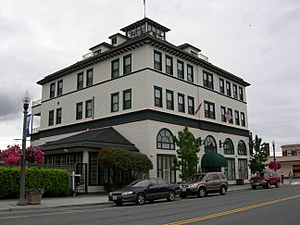
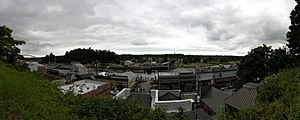
Cities
- Anacortes
- Burlington
- Mount Vernon (county seat)
- Sedro-Woolley
Towns
Census-designated places
Unincorporated communities
Reservations
- Swinomish Indian Reservation
- Upper Skagit Indian Reservation
- Samish Indian Reservation
Ghost towns
Education
Several school districts serve students in Skagit County:
- Anacortes School District
- Burlington-Edison School District
- Concrete School District
- Conway School District
- Darrington School District
- La Conner School District
- Mount Vernon School District
- Sedro-Woolley School District
See also
 In Spanish: Condado de Skagit para niños
In Spanish: Condado de Skagit para niños



